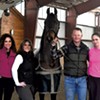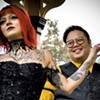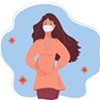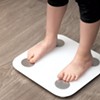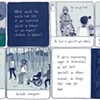Published June 29, 2021 at 10:00 a.m.
Summer is the time of year most often associated with sunburns. But the sun isn't the only seasonal hazard: Kids get burns from other items, too, such as metal slides, swings, sparklers and campfires.
Dr. Lewis First, chief of pediatrics at the University of Vermont Children's Hospital, says that the best approach is to prevent burns from happening. But if they occur, he offers some simple advice for soothing the pain and speeding the healing.
KIDS VT: What are the three types of burns parents should know about?
LEWIS FIRST: A first-degree burn is basically like a bad sunburn. It has redness but no blistering or broken skin and usually can be treated at home, unless it's more than three inches long. A second-degree burn is when you see blistering. A full-thickness or third-degree burn is when all layers of the skin and nerve endings have been destroyed. This child will require skin grafting to replace damaged skin and possibly underlying tissue. This is a true medical emergency and requires immediate attention.
KVT: How do burns commonly occur in the summer?
LF: The vast majority of burns to children result from contact with hot liquids such as tap water or items cooking on a stove. But about 20 percent result from contact with a hot objects.
Each year there are 10,000 visits to emergency rooms due to fireworks-related injuries, 3,000 of which are injuries to children under the age of 15. Half the fireworks injuries to children are caused by sparklers, which are not as benign as many parents assume. Sparklers can get as hot as 1,800 degrees and their sparks can cause burns to the face, hair and clothing.
KVT: When is it safe for kids to hold sparklers?
LF: Never give a sparkler to any child under 6, and children under 12 should never be allowed to light sparklers without adult supervision. Sparklers should be lit one at a time, and children should be instructed never to run with them or poke others. Never insert lit sparklers into someone's clothing, and once they're out, douse them in water. Ideally, kids should wear eye protection when holding one. My recommendation is to take children to see professional fireworks shows instead.
KVT: What do you recommend for kids at campfires?
LF: If there's a fire pit available, use it. If there is none, clear an area at least 10 feet away and downwind from where you're setting up tents and sleeping bags. Always have a shovel, plenty of water and, ideally, a fire extinguisher on hand. Never start a fire with flammable liquids such as gasoline.
Once the fire is going, kids should remain beyond a 10-foot radius around the fire until they're invited in to roast a marshmallow, and always under adult supervision. Even in summer, kids should wear long pants and covered shoes to prevent burns from sparks, ashes and hot coals. Tight-fitting clothing is safest for young children.
For roasting marshmallows, kids should use long sticks to avoid getting too close to the fire. Long hair should be pulled back and tucked into a shirt. There should be no running or horseplay, and kids should never be permitted to poke the fire or add more wood.
Beforehand, every child should know the directive to "stop, drop and roll" if someone catches fire. If this occurs, remove the clothing immediately unless it's stuck to the skin.
Most importantly, never go to sleep until the fire is completely out. Don't bury coals in the sand, because they can remain hot for 24 hours or more and can cause burns to bare feet.
KVT: What are the burn hazards on playgrounds?
LF: The good news is, many pieces of metal playground equipment are being replaced by plastic or metals treated with heat-reducing paints. But even slides, swings and other playground surfaces made of plastic or rubber can get very hot. In summer, it's best to go in the morning before the sun heats the equipment. Parents should touch the equipment with the back of their hand. If it's too hot to the touch, it's too dangerous for a child. Kids should wear closed-toed shoes that protect their feet from hot surfaces.
KVT: How should parents treat minor burns?
LF: Whether it's a minor first-degree burn that can be treated at home, or a more serious burn that requires medical attention, begin by running cool, but not ice-cold, water over it for at least five minutes. This helps ease the pain and reduce swelling. Never rub a burn or put ice on it, as this can cause frostbite. Never apply butter or grease, because they can actually generate heat and make it worse. Wash the burn with mild soap and water a day or two after it occurs.
KVT: What about using ointments or aloe?
LF: Aloe is fine on first-degree burns. But because it's not sterile, talk to your doctor before applying it on any open second-degree burns. If the skin is broken, your doctor is more likely to recommend an antibiotic ointment. The best approach is to keep it clean and covered with a loose, dry bandage, which should be changed every 24 hours. Acetaminophen or ibuprofen are fine for treating the pain.
KVT: When do burns require medical attention?
LF: If a blister forms or is more than two inches across, parents should seek medical attention. Additionally, any burn to a child's eyes, face, hands, feet, genitals, buttocks or joints should get examined because of the risk of scarring. Any electrical burn or a burn more than three inches long should be seen by a physician. An expert in pediatric burns can address cosmetic concerns, as well as the trauma of an injury that can be quite painful. Finally, if the child develops a fever, the wound oozes or the pain seems to be getting worse, seek medical care, as these may be signs of an infection.
This article was originally published in Seven Days' monthly parenting magazine, Kids VT.
Speaking of...
-

Video: Julianna and Sophia Parker of Otter Creek Wildlife Rescue Help Animals — and Humans, Too
Jun 30, 2022 -

Secondhand Style: Maternity Fashion to Beat the Heat
May 17, 2022 -

'Antiques Roadshow' to Make Its Vermont Debut
Jan 24, 2022 -

Video: Mike Santosusso Motorcycles to 100 Covered Bridges in a Year
Sep 9, 2021 -

Video: The Fourth Creemee Tour
Aug 26, 2021 - More »
Comments
Comments are closed.
From 2014-2020, Seven Days allowed readers to comment on all stories posted on our website. While we've appreciated the suggestions and insights, right now Seven Days is prioritizing our core mission — producing high-quality, responsible local journalism — over moderating online debates between readers.
To criticize, correct or praise our reporting, please send us a letter to the editor or send us a tip. We’ll check it out and report the results.
Online comments may return when we have better tech tools for managing them. Thanks for reading.





































